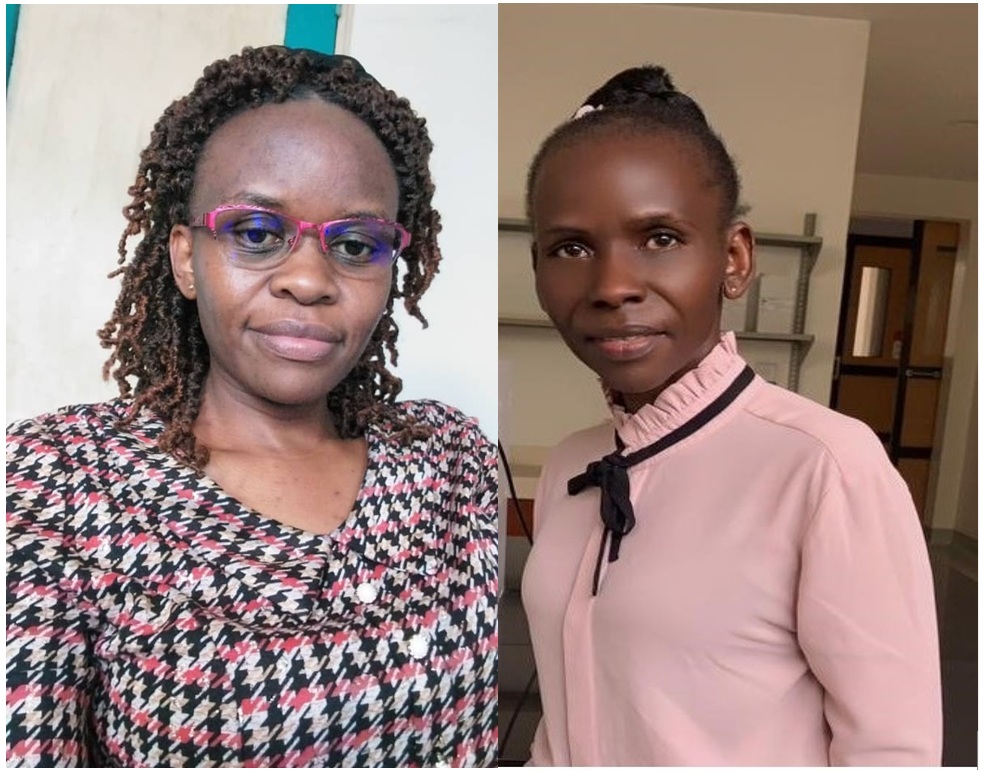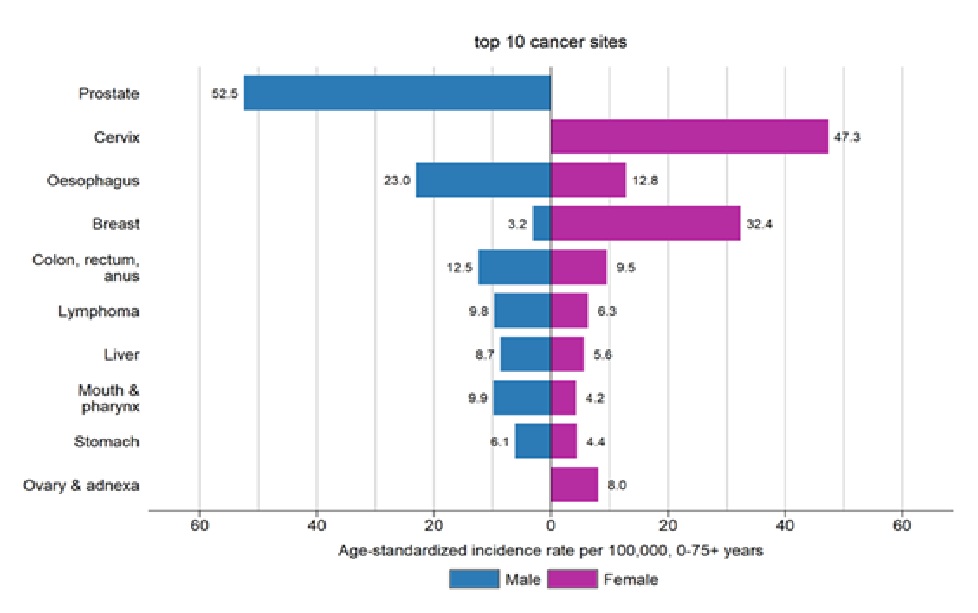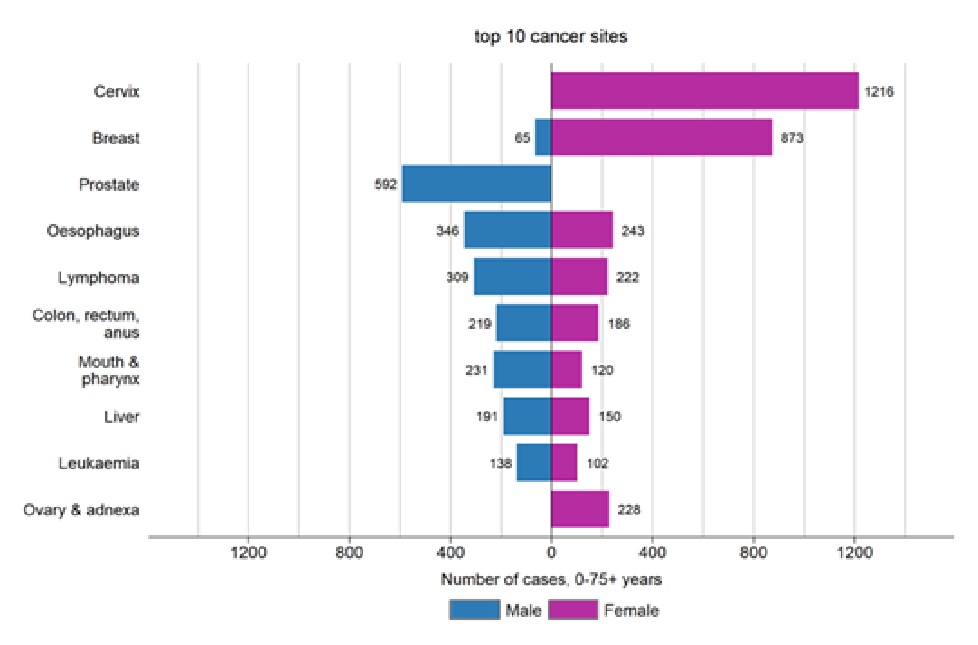Registry
The Kampala Cancer Registry was established in the Department of Pathology of Makerere Faculty of Medicine l (now the College of Health Sciences, Makerere University) in 1951 as a population-based cancer registry with the aim of determining cancer incidence in the population of Kyadondo County.

Personnel include a pathologist as a Director, a Cancer Registrar and a volunteer cancer registrar. All are employees of Makerere University.
The Registry has recruited staff of the medical records of various hospitals and medical units to assist in coordinating collection of data directly. For other hospitals, hospices and histopathology laboratories, the registrars make visits at least once a month, during which the hospital records - including admission and discharge registers, clinical notes and pathology reports – are consulted. For each case, both demographic and cancer diagnostic data are sought. Certification of death is only carried out for legal reasons and is very incomplete, so death certificates are not used as a source of information by the registry.
The registry is computerized and data management is carried out using the IARC/IACR CANREG software which includes checks for consistency and validity and permits search for potential duplicate registration. Completeness of registration was evaluated in 2001 as around 90% of adult cancer cases. Confidentiality is taken care of by using only CANREG registration numbers during analysis of data. The registry is out of bounds for unauthorized persons.
Contact details:
Kampala Cancer Registry
Department of Pathology – College of Health Sciences, Makerere University
PO Box 7072
Kampala
Uganda
Tel: +256 779083821/ +256783552846
Email: This email address is being protected from spambots. You need JavaScript enabled to view it.
Registration area
 The Kampala Cancer Registry collects data on the population of Kyadondo County, which includes the city of Kampala - the capital of Uganda - and a peri-urban area extending some 30 Km to the North. Kyadondo County lies on the equator at a longitude of approximately 340 E and covers an area of 1914 km2
The Kampala Cancer Registry collects data on the population of Kyadondo County, which includes the city of Kampala - the capital of Uganda - and a peri-urban area extending some 30 Km to the North. Kyadondo County lies on the equator at a longitude of approximately 340 E and covers an area of 1914 km2
The inhabitants come from all of the 65 ethnic groups found in Uganda, although the majority is from the Ganda ethnicity. There are also many migrants from neighbouring countries, particularly from Kenya, South Sudan, Somalia and Rwanda. One percent of the population is of European and Asian origin. The main activities of the residents include trade, administration, professional and semi-professional jobs, personal services, and plant and machine operators. Subsistence farming is also practiced including in the urban areas. Majority of the population are Catholic, followed by Anglican, Muslim and other religions. Population was estimated as 3.67 million from the 2024 Census.
Results
Since the inception of the registry in 1951, the geographical area covered has not changed boundaries. From the most recent census of 2024 by the Uganda Bureau of Statistics (UBOS), there has been a population increase in the urban and rural areas of Kyadondo County. In addition, an increasing number of people come to urban areas to look for work and for better standards of living than in rural villages, and these factors may influence incidence rates of cancer in this community. Another factor which may influence incidence rates of cancer is the availability of diagnostic services, which is improving, particularly in the urban areas. The most comprehensive oncology services, with a focus on The Cancer Institute, in the country is located within Kyadondo county. This includes both cancer diagnostic and treatment services. Uganda has been active in programmes for prevention and control of HIV-AIDS, with a variety of governmental, voluntary and research organisations providing free diagnosis and treatment with ARVs. This has resulted in a change of incidence of AIDS related cancers. Of greatest significance among these is Kaposi sarcoma.

Top 10 cancers (2013-2017), both sexes (Age-standardized rate per 100,000)

Top 10 cancers (2013-2017), both sexes (Number of cases)
Use of the data
The registry provides the longest time series of cancer incidence in Africa. This makes the data of special value for cancer surveillance and research, particularly in monitoring the epidemic of HIV/AIDS and as a baseline for analytical studies and intervention studies. Cancer screening is opportunistic and mainly focusing on cervical cancer amongst HIV positive women. The major mode of screening for breast cancer being advocated for is self-breast examination. Mammography is available in limited number of facilities and expensive for the ordinary Ugandan.
A report for the years 2013-2017 was published 2017 and is available at the registry.
The data is also used in planning for cancer control activities and in the National cancer control plan.
Publications
The registry has published its data in various books, including the Cancer Incidence in Five Continents Series Volume I, VII, VIII, IX, X, XI and XII, and in numerous journal articles, as well as participating in a wide variety of research studies:
- Wabinga HR, Nambooze S, Amulen PM, Okello C, Mbus L, Parkin DM. Trends in the incidence of cancer in Kampala, Uganda 1991-2010. Int J Cancer. 2014 July 135(2):432-439
- Wabinga H, Parkin DM, Nambooze S, Amero J. Cancer survival in Kampala, Uganda,1993-1997. IARC Sci Publ. 2011;(162):243-7
- Parkin DM, Nambooze S, Wabwire-Mangen F, Wabinga HR. Changing cancer incidence in Kampala, Uganda, 1991-2006. Int J Cancer. 2010 Mar 1;126(5):1187-95
- Mbulaiteye SM, Katabira ET, Wabinga H, Parkin DM, Virgo P, Ochai R, Workneh M, Coutinho A, Engels EA. Spectrum of cancers among HIV-infected persons in Africa: the Uganda AIDS-Cancer Registry Match Study. Int J Cancer. 2006 Feb 15;118(4):985-90
- Gondos A, Brenner H, Wabinga H, Parkin DM. Cancer survival in Kampala, Uganda. Br J Cancer. 2005 May 9;92(9):1808-12. PubMed PMID: 15827554
- Wabinga H, Ramanakumar AV, Banura C, Luwaga A, Nambooze S, Parkin DM. Survival of cervix cancer patients in Kampala, Uganda: 1995-1997. Br J Cancer. 2003 Jul 7;89(1):65-9. PubMed PMID: 12838301
- Parkin DM, Wabinga H, Nambooze S. Completeness in an African cancer registry. Cancer Causes Control. 2001 Feb;12(2):147-52
- Wabinga HR, Parkin DM, Wabwire-Mangen F, Nambooze S. Trends in cancer incidence in Kyadondo County, Uganda, 1960-1997. Br J Cancer. 2000 May;82(9):1585-92
- Wabinga HR, Parkin DM, Wabwire-Mangen F, Mugerwa JW. Cancer in Kampala,Uganda, in 1989-91: changes in incidence in the era of AIDS. Int J Cancer. 1993 Apr 22;54(1):26-3
- Phiona Bukirwa, Henry Wabinga, Sarah Nambooze, Phoebe Mary Amulen, Walburga Yvonne Joko, Biying Liu, Donald Maxwell Parkin. Trends in the incidence of cancer in Kampala, Uganda, 1991 to 2015. Int J Cancer. 2020 Oct 31
- Gizaw, M., Parkin, D. M., Stöter, O., Bukirwa, P., Seife, E., Chesumbai, G., ... & Kantelhardt, E. J. (2024). Ovarian cancer survival in sub‐Saharan Africa by human development index and histological subtypes: A population‐based registry study. International Journal of Cancer.
- Moen, L., Liu, B., Bukirwa, P., Chingonzoh, T., Chokunonga, E., Finesse, A., ... & Parkin, D. M. (2024). Trends in the incidence of colorectal cancer in sub‐Saharan Africa: A population‐based registry study. International Journal of Cancer.
Updated July 2025
